Developing a Business Idea: Market and Financial Feasibility Report
VerifiedAdded on 2021/05/31
|12
|2616
|36
Report
AI Summary
This report details a business idea for manufacturing T-Computers, devices combining computer and TV functionalities. The report analyzes the market gap, identifying the convenience of an integrated device as a key advantage. It explores the benefits, including job creation, tax revenue, and improved efficiency. The feasibility section assesses market and financial viability, with a focus on targeting the youth and middle-aged demographic in Tokyo, Japan. The proposed business model utilizes a long-tail approach, concentrating on profitable customer segments. Critical success factors, such as service orientation, technology adoption, and employee motivation, are emphasized. The report concludes with a positive outlook, anticipating success through careful consideration of market dynamics and strategic planning.
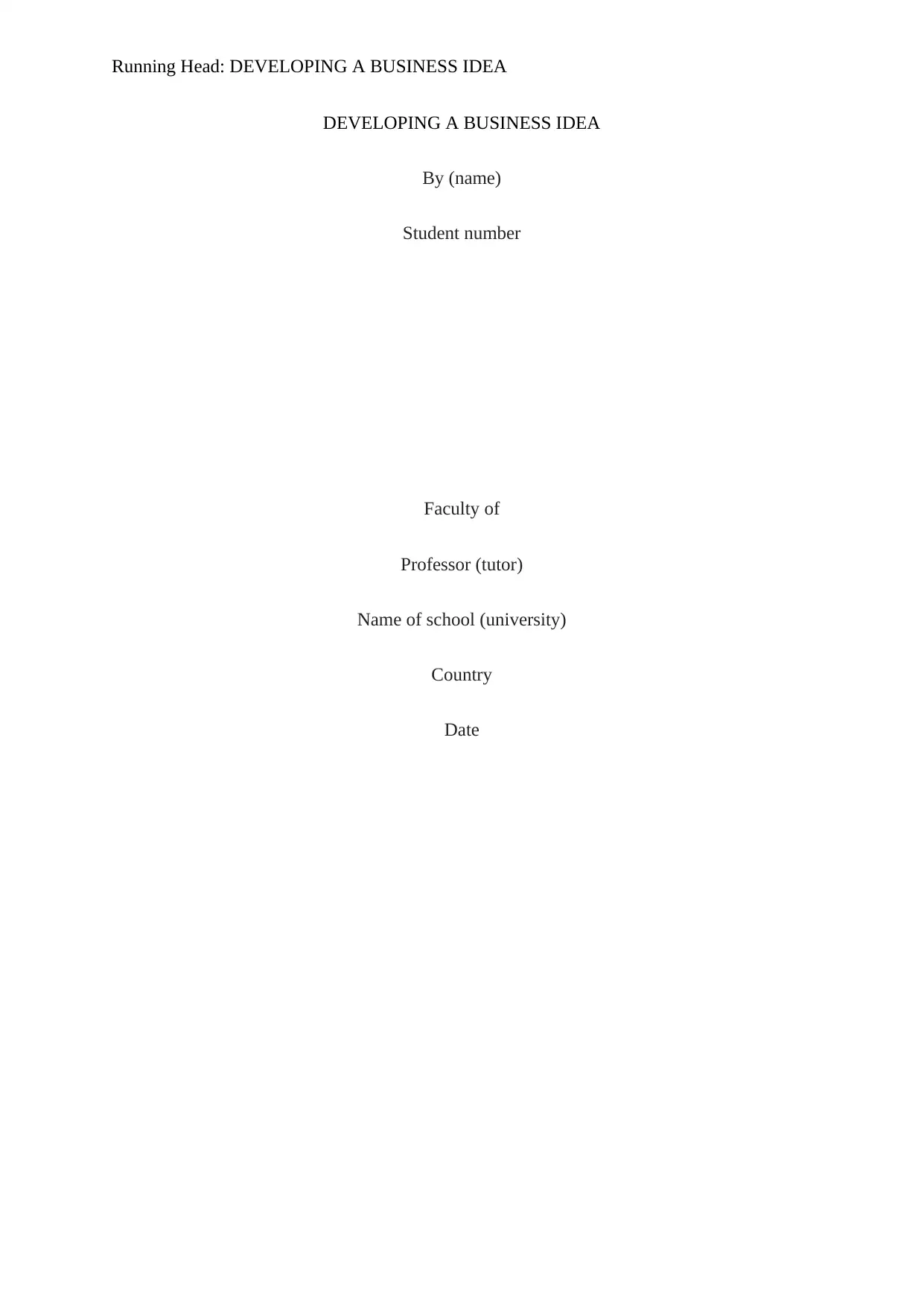
Running Head: DEVELOPING A BUSINESS IDEA
DEVELOPING A BUSINESS IDEA
By (name)
Student number
Faculty of
Professor (tutor)
Name of school (university)
Country
Date
DEVELOPING A BUSINESS IDEA
By (name)
Student number
Faculty of
Professor (tutor)
Name of school (university)
Country
Date
Paraphrase This Document
Need a fresh take? Get an instant paraphrase of this document with our AI Paraphraser
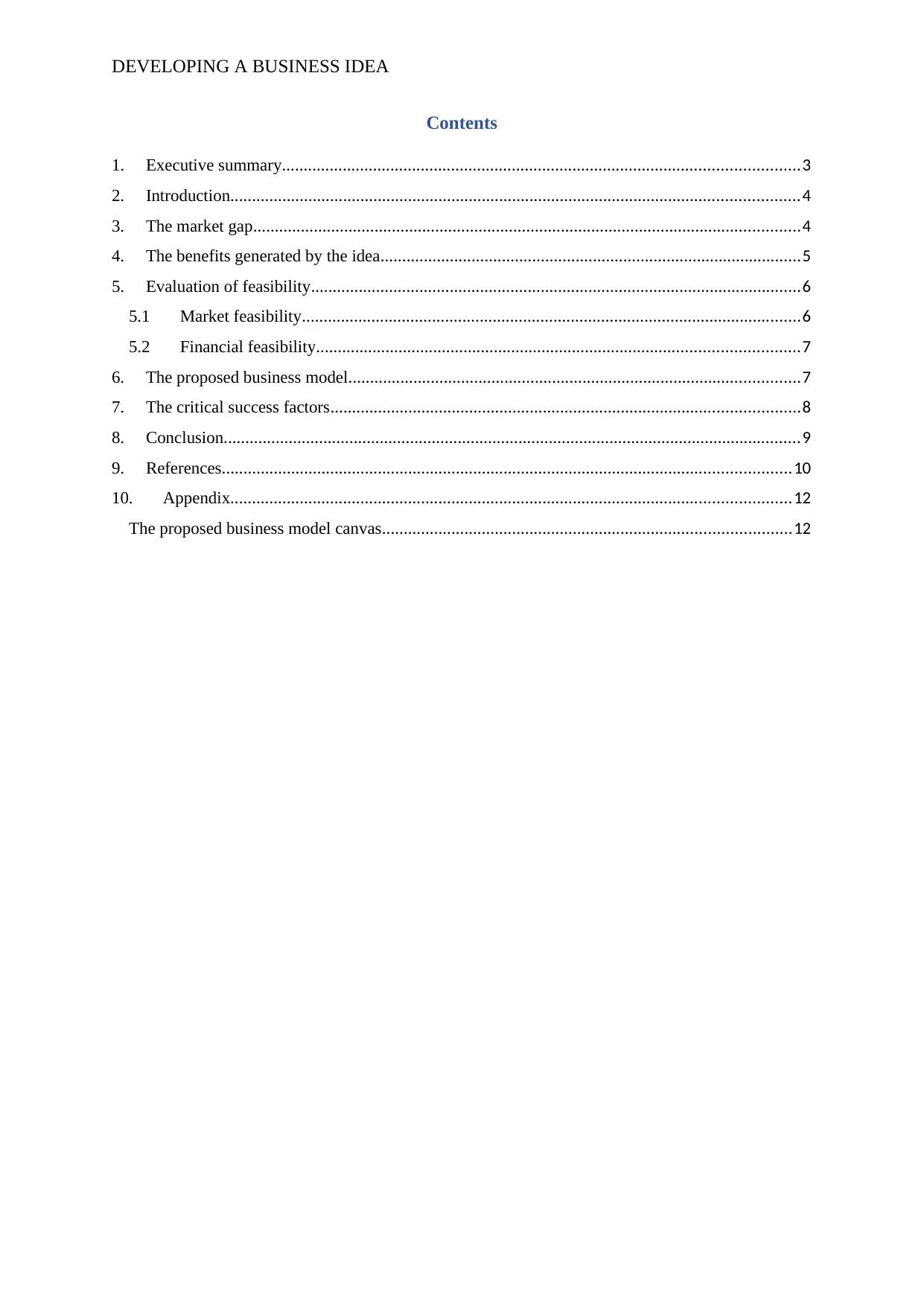
DEVELOPING A BUSINESS IDEA
Contents
1. Executive summary.......................................................................................................................3
2. Introduction...................................................................................................................................4
3. The market gap..............................................................................................................................4
4. The benefits generated by the idea.................................................................................................5
5. Evaluation of feasibility.................................................................................................................6
5.1 Market feasibility...................................................................................................................6
5.2 Financial feasibility...............................................................................................................7
6. The proposed business model........................................................................................................7
7. The critical success factors............................................................................................................8
8. Conclusion.....................................................................................................................................9
9. References...................................................................................................................................10
10. Appendix.................................................................................................................................12
The proposed business model canvas..............................................................................................12
Contents
1. Executive summary.......................................................................................................................3
2. Introduction...................................................................................................................................4
3. The market gap..............................................................................................................................4
4. The benefits generated by the idea.................................................................................................5
5. Evaluation of feasibility.................................................................................................................6
5.1 Market feasibility...................................................................................................................6
5.2 Financial feasibility...............................................................................................................7
6. The proposed business model........................................................................................................7
7. The critical success factors............................................................................................................8
8. Conclusion.....................................................................................................................................9
9. References...................................................................................................................................10
10. Appendix.................................................................................................................................12
The proposed business model canvas..............................................................................................12
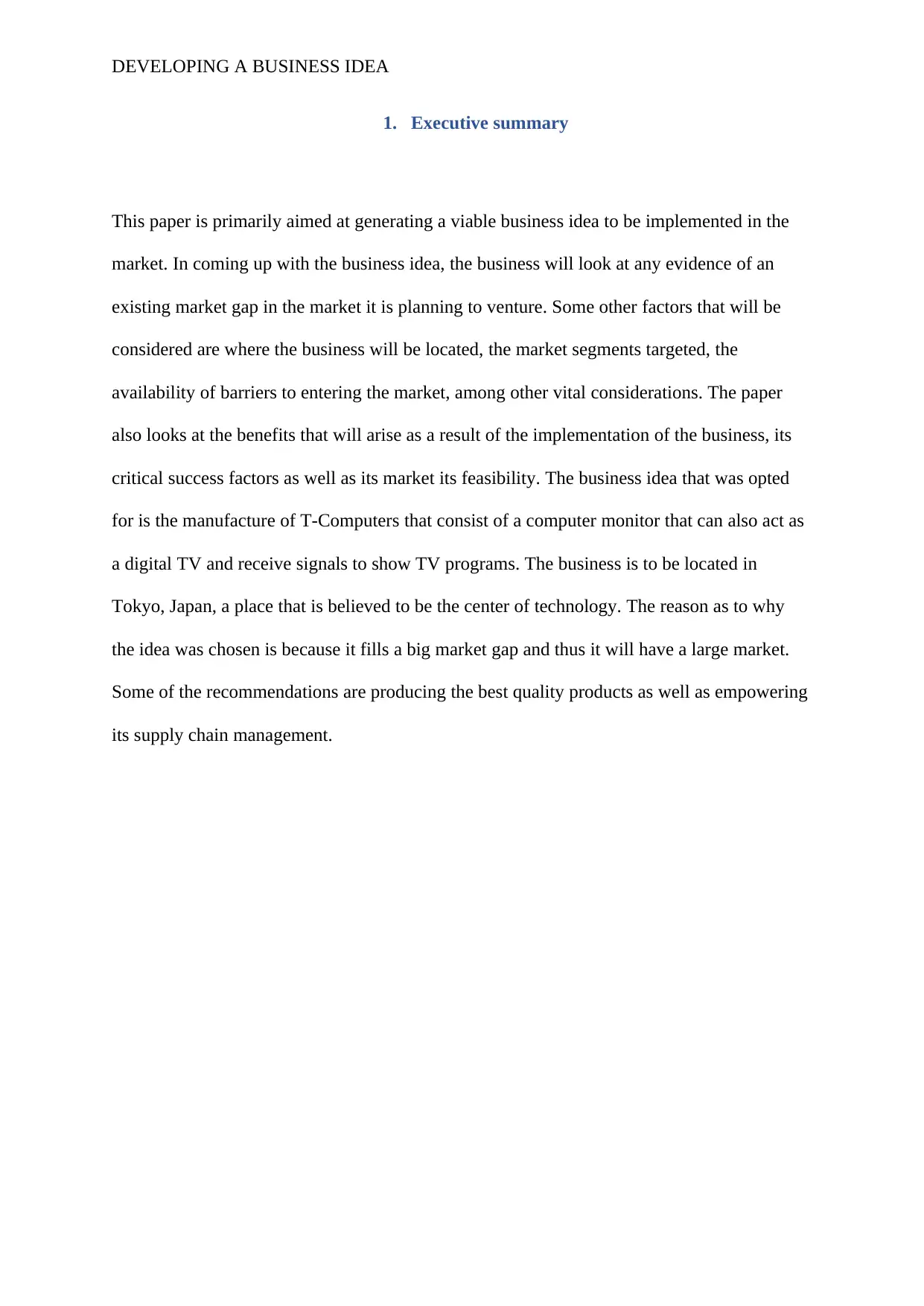
DEVELOPING A BUSINESS IDEA
1. Executive summary
This paper is primarily aimed at generating a viable business idea to be implemented in the
market. In coming up with the business idea, the business will look at any evidence of an
existing market gap in the market it is planning to venture. Some other factors that will be
considered are where the business will be located, the market segments targeted, the
availability of barriers to entering the market, among other vital considerations. The paper
also looks at the benefits that will arise as a result of the implementation of the business, its
critical success factors as well as its market its feasibility. The business idea that was opted
for is the manufacture of T-Computers that consist of a computer monitor that can also act as
a digital TV and receive signals to show TV programs. The business is to be located in
Tokyo, Japan, a place that is believed to be the center of technology. The reason as to why
the idea was chosen is because it fills a big market gap and thus it will have a large market.
Some of the recommendations are producing the best quality products as well as empowering
its supply chain management.
1. Executive summary
This paper is primarily aimed at generating a viable business idea to be implemented in the
market. In coming up with the business idea, the business will look at any evidence of an
existing market gap in the market it is planning to venture. Some other factors that will be
considered are where the business will be located, the market segments targeted, the
availability of barriers to entering the market, among other vital considerations. The paper
also looks at the benefits that will arise as a result of the implementation of the business, its
critical success factors as well as its market its feasibility. The business idea that was opted
for is the manufacture of T-Computers that consist of a computer monitor that can also act as
a digital TV and receive signals to show TV programs. The business is to be located in
Tokyo, Japan, a place that is believed to be the center of technology. The reason as to why
the idea was chosen is because it fills a big market gap and thus it will have a large market.
Some of the recommendations are producing the best quality products as well as empowering
its supply chain management.
⊘ This is a preview!⊘
Do you want full access?
Subscribe today to unlock all pages.

Trusted by 1+ million students worldwide
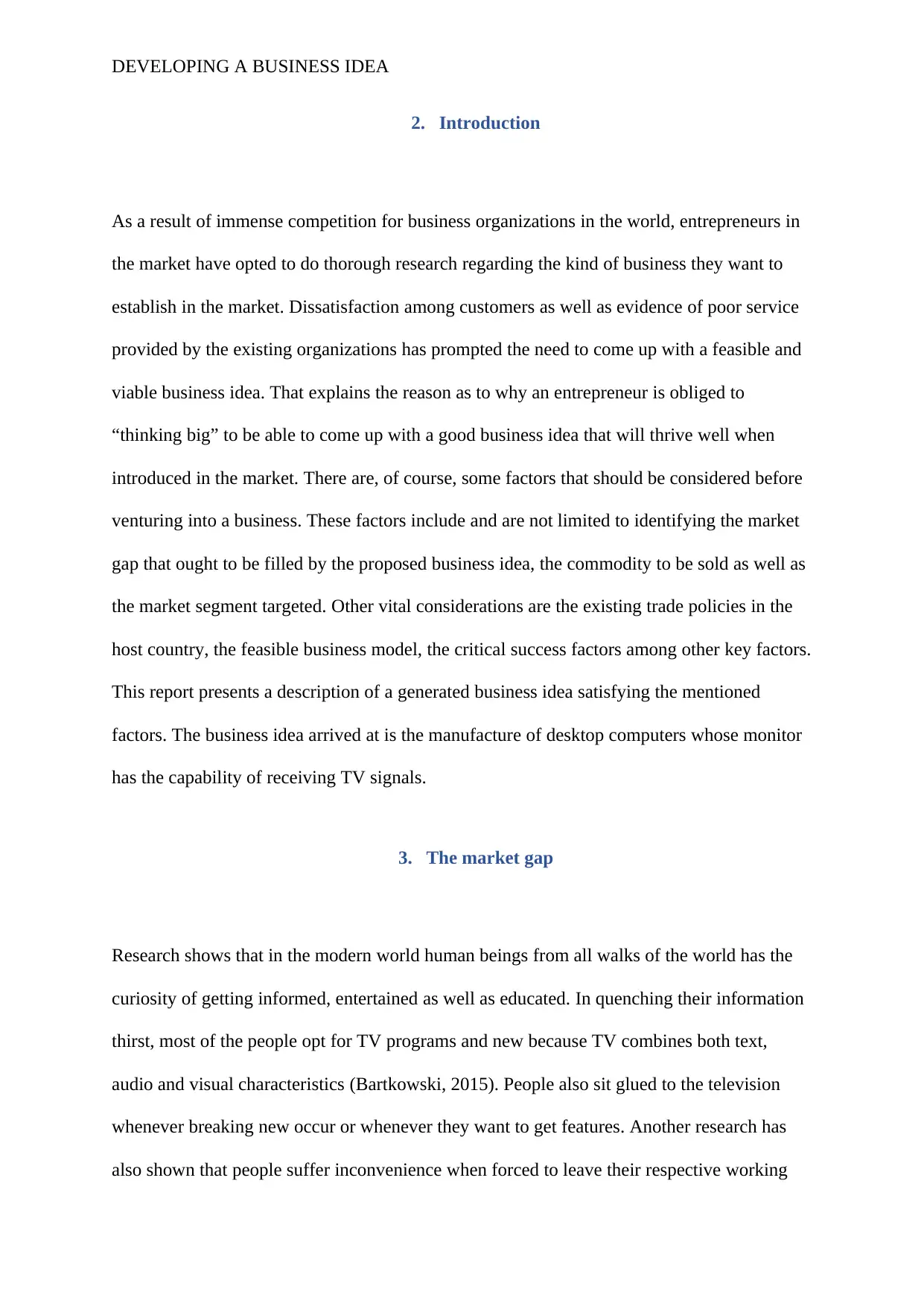
DEVELOPING A BUSINESS IDEA
2. Introduction
As a result of immense competition for business organizations in the world, entrepreneurs in
the market have opted to do thorough research regarding the kind of business they want to
establish in the market. Dissatisfaction among customers as well as evidence of poor service
provided by the existing organizations has prompted the need to come up with a feasible and
viable business idea. That explains the reason as to why an entrepreneur is obliged to
“thinking big” to be able to come up with a good business idea that will thrive well when
introduced in the market. There are, of course, some factors that should be considered before
venturing into a business. These factors include and are not limited to identifying the market
gap that ought to be filled by the proposed business idea, the commodity to be sold as well as
the market segment targeted. Other vital considerations are the existing trade policies in the
host country, the feasible business model, the critical success factors among other key factors.
This report presents a description of a generated business idea satisfying the mentioned
factors. The business idea arrived at is the manufacture of desktop computers whose monitor
has the capability of receiving TV signals.
3. The market gap
Research shows that in the modern world human beings from all walks of the world has the
curiosity of getting informed, entertained as well as educated. In quenching their information
thirst, most of the people opt for TV programs and new because TV combines both text,
audio and visual characteristics (Bartkowski, 2015). People also sit glued to the television
whenever breaking new occur or whenever they want to get features. Another research has
also shown that people suffer inconvenience when forced to leave their respective working
2. Introduction
As a result of immense competition for business organizations in the world, entrepreneurs in
the market have opted to do thorough research regarding the kind of business they want to
establish in the market. Dissatisfaction among customers as well as evidence of poor service
provided by the existing organizations has prompted the need to come up with a feasible and
viable business idea. That explains the reason as to why an entrepreneur is obliged to
“thinking big” to be able to come up with a good business idea that will thrive well when
introduced in the market. There are, of course, some factors that should be considered before
venturing into a business. These factors include and are not limited to identifying the market
gap that ought to be filled by the proposed business idea, the commodity to be sold as well as
the market segment targeted. Other vital considerations are the existing trade policies in the
host country, the feasible business model, the critical success factors among other key factors.
This report presents a description of a generated business idea satisfying the mentioned
factors. The business idea arrived at is the manufacture of desktop computers whose monitor
has the capability of receiving TV signals.
3. The market gap
Research shows that in the modern world human beings from all walks of the world has the
curiosity of getting informed, entertained as well as educated. In quenching their information
thirst, most of the people opt for TV programs and new because TV combines both text,
audio and visual characteristics (Bartkowski, 2015). People also sit glued to the television
whenever breaking new occur or whenever they want to get features. Another research has
also shown that people suffer inconvenience when forced to leave their respective working
Paraphrase This Document
Need a fresh take? Get an instant paraphrase of this document with our AI Paraphraser
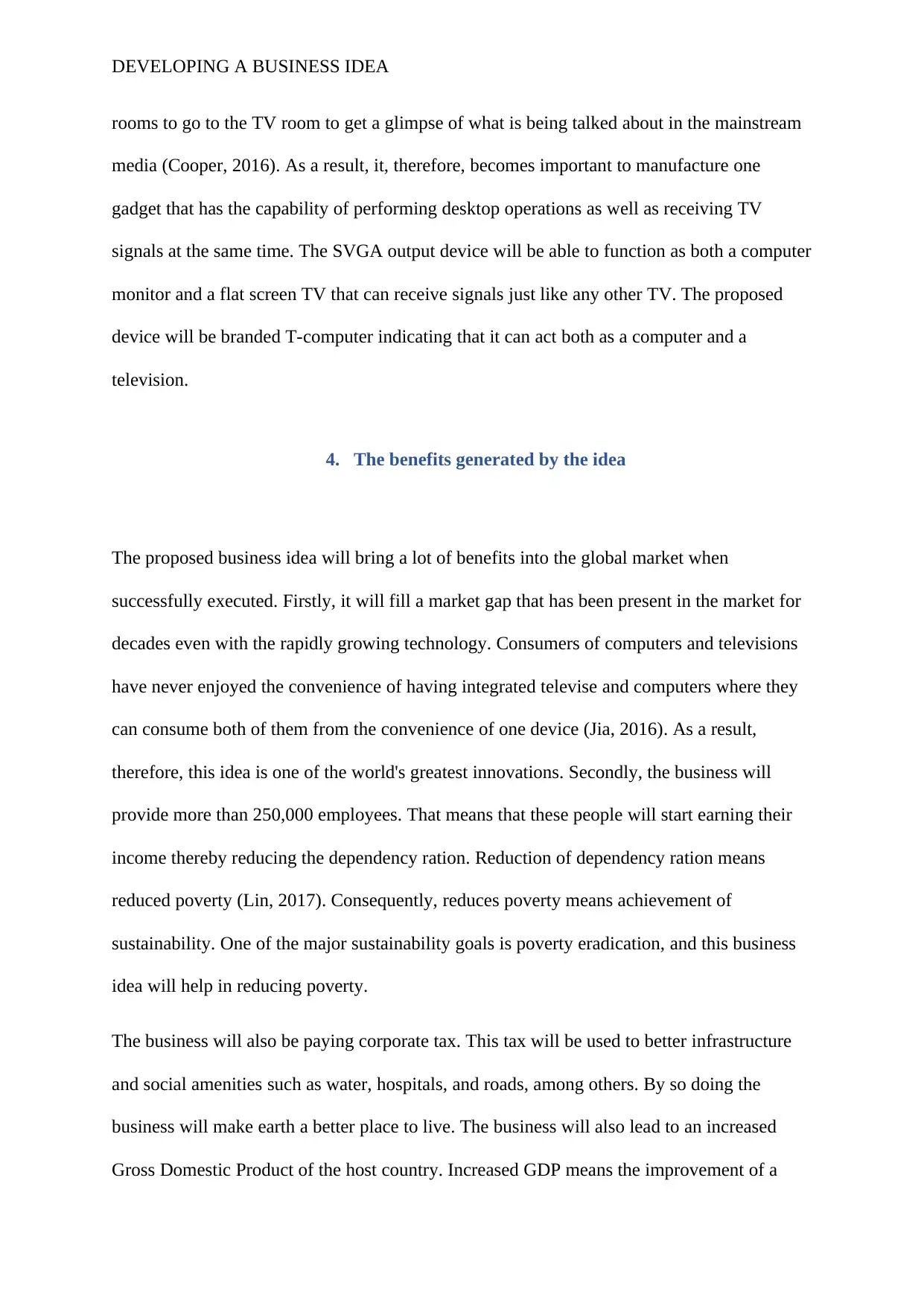
DEVELOPING A BUSINESS IDEA
rooms to go to the TV room to get a glimpse of what is being talked about in the mainstream
media (Cooper, 2016). As a result, it, therefore, becomes important to manufacture one
gadget that has the capability of performing desktop operations as well as receiving TV
signals at the same time. The SVGA output device will be able to function as both a computer
monitor and a flat screen TV that can receive signals just like any other TV. The proposed
device will be branded T-computer indicating that it can act both as a computer and a
television.
4. The benefits generated by the idea
The proposed business idea will bring a lot of benefits into the global market when
successfully executed. Firstly, it will fill a market gap that has been present in the market for
decades even with the rapidly growing technology. Consumers of computers and televisions
have never enjoyed the convenience of having integrated televise and computers where they
can consume both of them from the convenience of one device (Jia, 2016). As a result,
therefore, this idea is one of the world's greatest innovations. Secondly, the business will
provide more than 250,000 employees. That means that these people will start earning their
income thereby reducing the dependency ration. Reduction of dependency ration means
reduced poverty (Lin, 2017). Consequently, reduces poverty means achievement of
sustainability. One of the major sustainability goals is poverty eradication, and this business
idea will help in reducing poverty.
The business will also be paying corporate tax. This tax will be used to better infrastructure
and social amenities such as water, hospitals, and roads, among others. By so doing the
business will make earth a better place to live. The business will also lead to an increased
Gross Domestic Product of the host country. Increased GDP means the improvement of a
rooms to go to the TV room to get a glimpse of what is being talked about in the mainstream
media (Cooper, 2016). As a result, it, therefore, becomes important to manufacture one
gadget that has the capability of performing desktop operations as well as receiving TV
signals at the same time. The SVGA output device will be able to function as both a computer
monitor and a flat screen TV that can receive signals just like any other TV. The proposed
device will be branded T-computer indicating that it can act both as a computer and a
television.
4. The benefits generated by the idea
The proposed business idea will bring a lot of benefits into the global market when
successfully executed. Firstly, it will fill a market gap that has been present in the market for
decades even with the rapidly growing technology. Consumers of computers and televisions
have never enjoyed the convenience of having integrated televise and computers where they
can consume both of them from the convenience of one device (Jia, 2016). As a result,
therefore, this idea is one of the world's greatest innovations. Secondly, the business will
provide more than 250,000 employees. That means that these people will start earning their
income thereby reducing the dependency ration. Reduction of dependency ration means
reduced poverty (Lin, 2017). Consequently, reduces poverty means achievement of
sustainability. One of the major sustainability goals is poverty eradication, and this business
idea will help in reducing poverty.
The business will also be paying corporate tax. This tax will be used to better infrastructure
and social amenities such as water, hospitals, and roads, among others. By so doing the
business will make earth a better place to live. The business will also lead to an increased
Gross Domestic Product of the host country. Increased GDP means the improvement of a
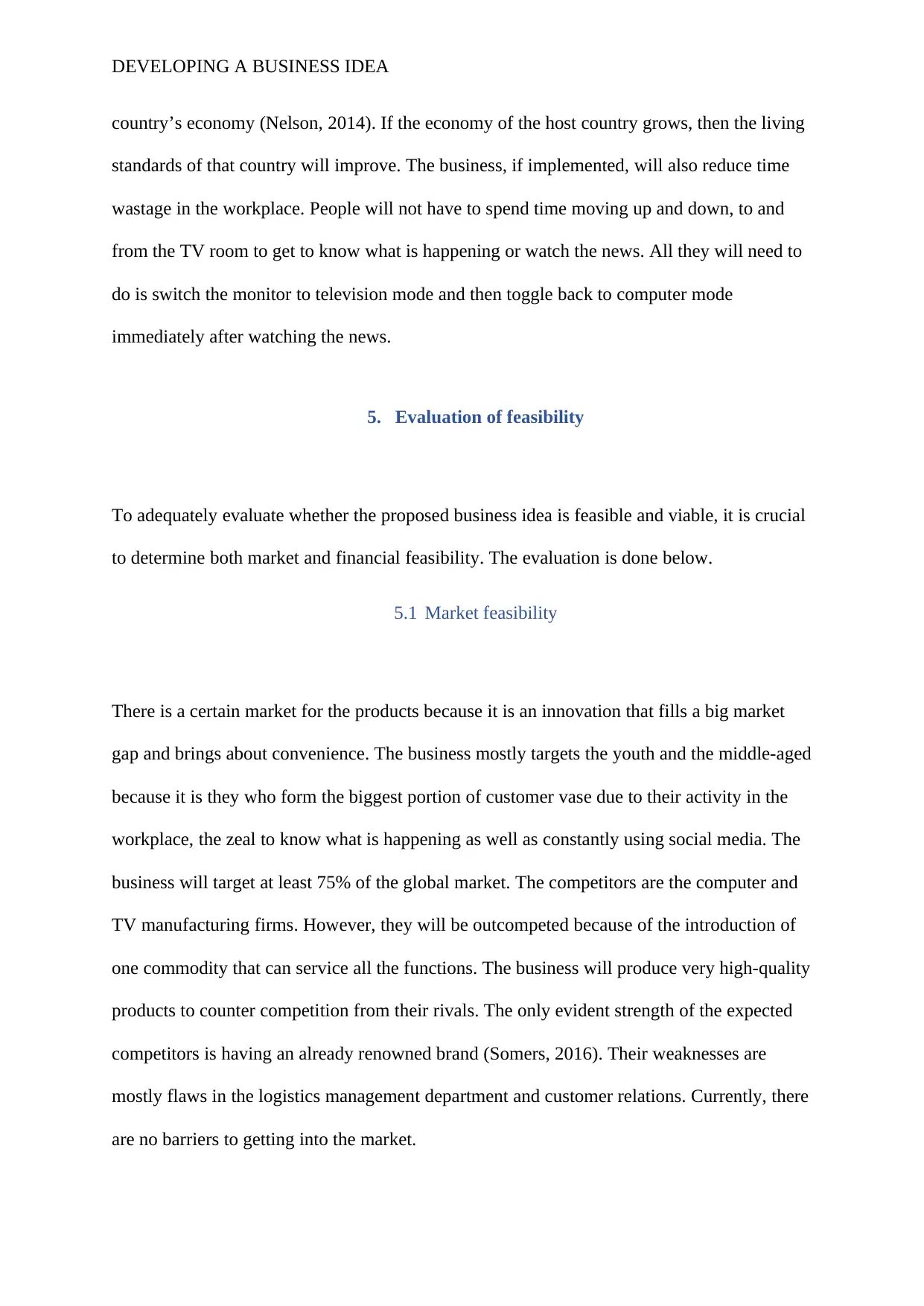
DEVELOPING A BUSINESS IDEA
country’s economy (Nelson, 2014). If the economy of the host country grows, then the living
standards of that country will improve. The business, if implemented, will also reduce time
wastage in the workplace. People will not have to spend time moving up and down, to and
from the TV room to get to know what is happening or watch the news. All they will need to
do is switch the monitor to television mode and then toggle back to computer mode
immediately after watching the news.
5. Evaluation of feasibility
To adequately evaluate whether the proposed business idea is feasible and viable, it is crucial
to determine both market and financial feasibility. The evaluation is done below.
5.1 Market feasibility
There is a certain market for the products because it is an innovation that fills a big market
gap and brings about convenience. The business mostly targets the youth and the middle-aged
because it is they who form the biggest portion of customer vase due to their activity in the
workplace, the zeal to know what is happening as well as constantly using social media. The
business will target at least 75% of the global market. The competitors are the computer and
TV manufacturing firms. However, they will be outcompeted because of the introduction of
one commodity that can service all the functions. The business will produce very high-quality
products to counter competition from their rivals. The only evident strength of the expected
competitors is having an already renowned brand (Somers, 2016). Their weaknesses are
mostly flaws in the logistics management department and customer relations. Currently, there
are no barriers to getting into the market.
country’s economy (Nelson, 2014). If the economy of the host country grows, then the living
standards of that country will improve. The business, if implemented, will also reduce time
wastage in the workplace. People will not have to spend time moving up and down, to and
from the TV room to get to know what is happening or watch the news. All they will need to
do is switch the monitor to television mode and then toggle back to computer mode
immediately after watching the news.
5. Evaluation of feasibility
To adequately evaluate whether the proposed business idea is feasible and viable, it is crucial
to determine both market and financial feasibility. The evaluation is done below.
5.1 Market feasibility
There is a certain market for the products because it is an innovation that fills a big market
gap and brings about convenience. The business mostly targets the youth and the middle-aged
because it is they who form the biggest portion of customer vase due to their activity in the
workplace, the zeal to know what is happening as well as constantly using social media. The
business will target at least 75% of the global market. The competitors are the computer and
TV manufacturing firms. However, they will be outcompeted because of the introduction of
one commodity that can service all the functions. The business will produce very high-quality
products to counter competition from their rivals. The only evident strength of the expected
competitors is having an already renowned brand (Somers, 2016). Their weaknesses are
mostly flaws in the logistics management department and customer relations. Currently, there
are no barriers to getting into the market.
⊘ This is a preview!⊘
Do you want full access?
Subscribe today to unlock all pages.

Trusted by 1+ million students worldwide
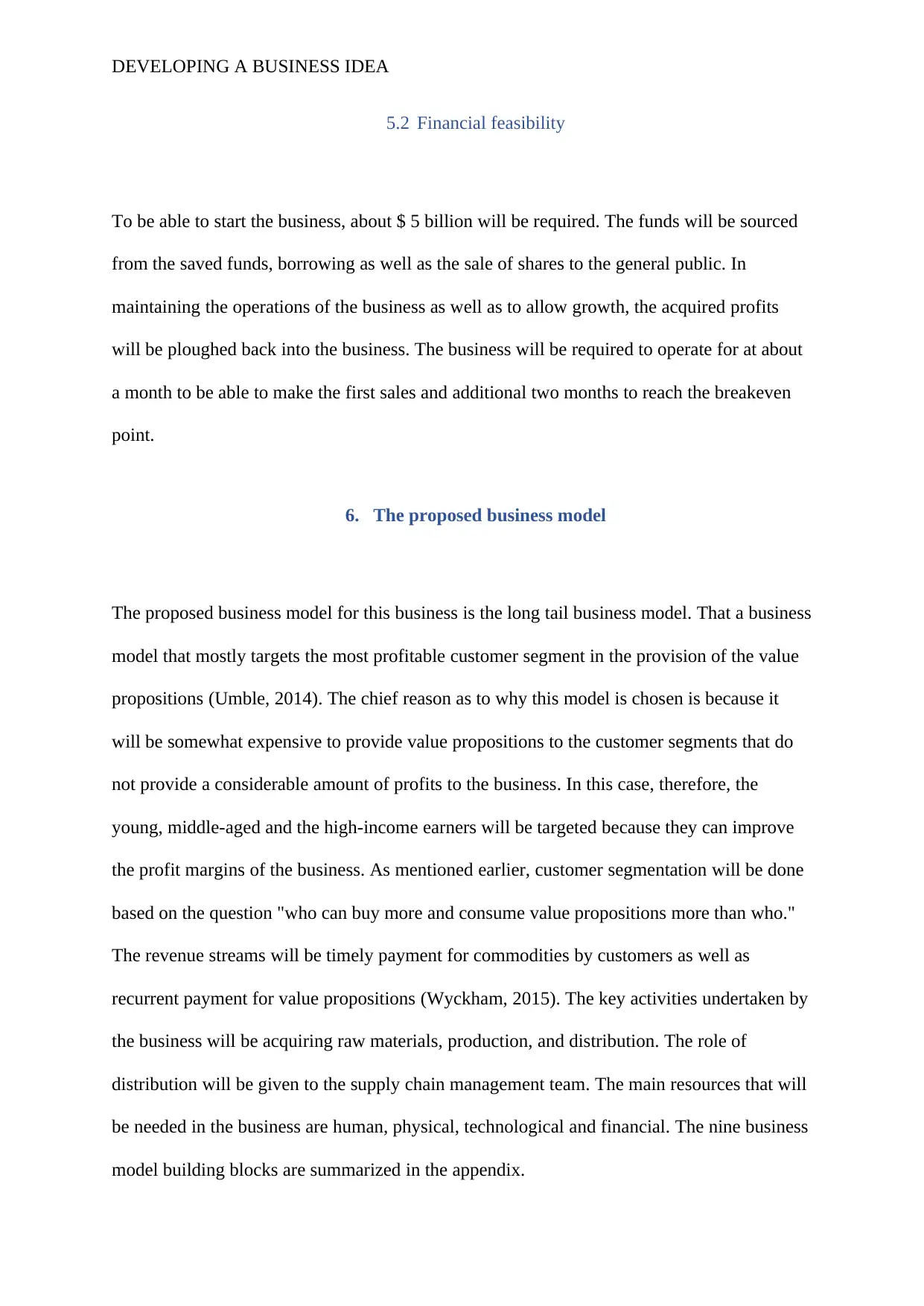
DEVELOPING A BUSINESS IDEA
5.2 Financial feasibility
To be able to start the business, about $ 5 billion will be required. The funds will be sourced
from the saved funds, borrowing as well as the sale of shares to the general public. In
maintaining the operations of the business as well as to allow growth, the acquired profits
will be ploughed back into the business. The business will be required to operate for at about
a month to be able to make the first sales and additional two months to reach the breakeven
point.
6. The proposed business model
The proposed business model for this business is the long tail business model. That a business
model that mostly targets the most profitable customer segment in the provision of the value
propositions (Umble, 2014). The chief reason as to why this model is chosen is because it
will be somewhat expensive to provide value propositions to the customer segments that do
not provide a considerable amount of profits to the business. In this case, therefore, the
young, middle-aged and the high-income earners will be targeted because they can improve
the profit margins of the business. As mentioned earlier, customer segmentation will be done
based on the question "who can buy more and consume value propositions more than who."
The revenue streams will be timely payment for commodities by customers as well as
recurrent payment for value propositions (Wyckham, 2015). The key activities undertaken by
the business will be acquiring raw materials, production, and distribution. The role of
distribution will be given to the supply chain management team. The main resources that will
be needed in the business are human, physical, technological and financial. The nine business
model building blocks are summarized in the appendix.
5.2 Financial feasibility
To be able to start the business, about $ 5 billion will be required. The funds will be sourced
from the saved funds, borrowing as well as the sale of shares to the general public. In
maintaining the operations of the business as well as to allow growth, the acquired profits
will be ploughed back into the business. The business will be required to operate for at about
a month to be able to make the first sales and additional two months to reach the breakeven
point.
6. The proposed business model
The proposed business model for this business is the long tail business model. That a business
model that mostly targets the most profitable customer segment in the provision of the value
propositions (Umble, 2014). The chief reason as to why this model is chosen is because it
will be somewhat expensive to provide value propositions to the customer segments that do
not provide a considerable amount of profits to the business. In this case, therefore, the
young, middle-aged and the high-income earners will be targeted because they can improve
the profit margins of the business. As mentioned earlier, customer segmentation will be done
based on the question "who can buy more and consume value propositions more than who."
The revenue streams will be timely payment for commodities by customers as well as
recurrent payment for value propositions (Wyckham, 2015). The key activities undertaken by
the business will be acquiring raw materials, production, and distribution. The role of
distribution will be given to the supply chain management team. The main resources that will
be needed in the business are human, physical, technological and financial. The nine business
model building blocks are summarized in the appendix.
Paraphrase This Document
Need a fresh take? Get an instant paraphrase of this document with our AI Paraphraser
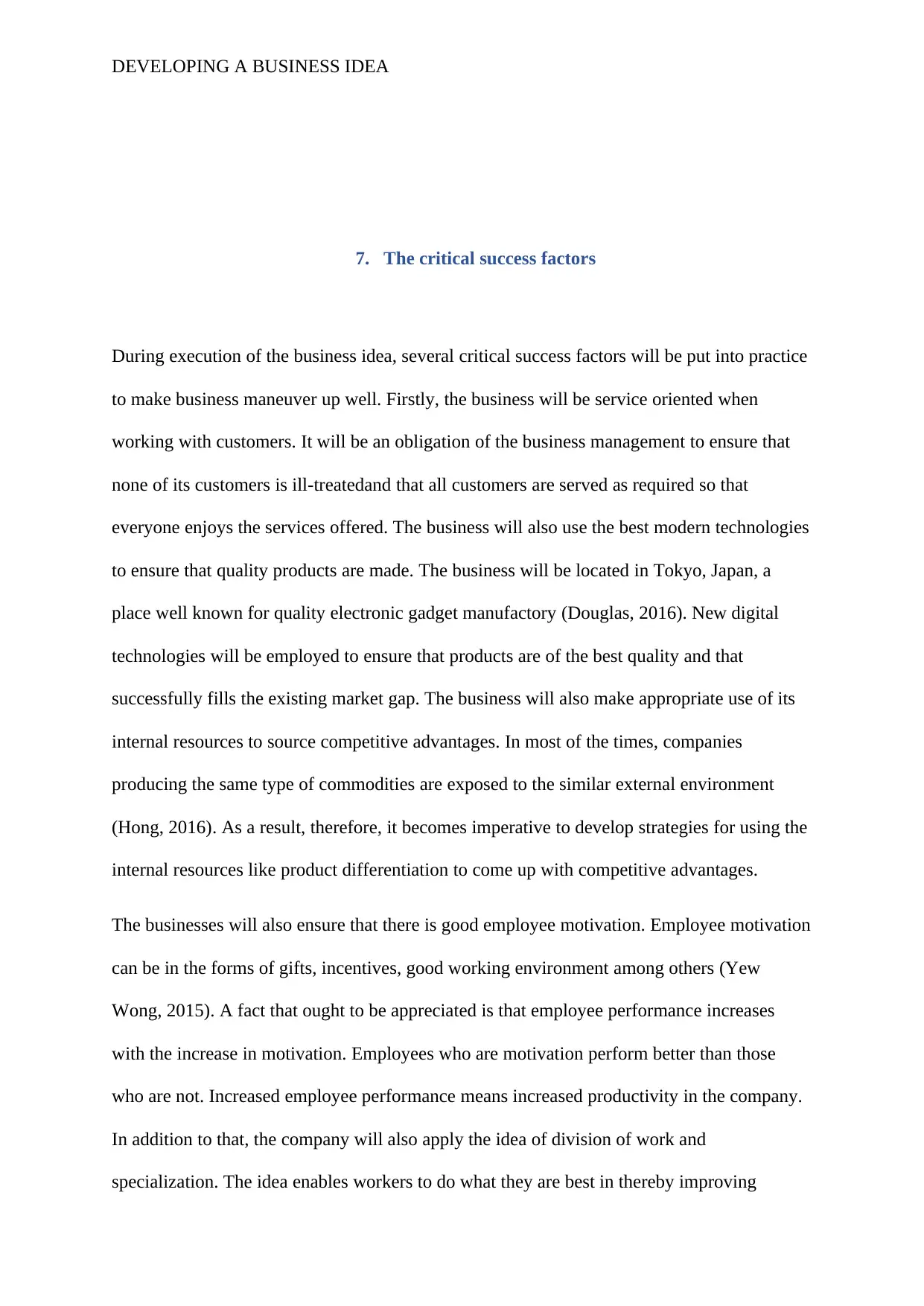
DEVELOPING A BUSINESS IDEA
7. The critical success factors
During execution of the business idea, several critical success factors will be put into practice
to make business maneuver up well. Firstly, the business will be service oriented when
working with customers. It will be an obligation of the business management to ensure that
none of its customers is ill-treatedand that all customers are served as required so that
everyone enjoys the services offered. The business will also use the best modern technologies
to ensure that quality products are made. The business will be located in Tokyo, Japan, a
place well known for quality electronic gadget manufactory (Douglas, 2016). New digital
technologies will be employed to ensure that products are of the best quality and that
successfully fills the existing market gap. The business will also make appropriate use of its
internal resources to source competitive advantages. In most of the times, companies
producing the same type of commodities are exposed to the similar external environment
(Hong, 2016). As a result, therefore, it becomes imperative to develop strategies for using the
internal resources like product differentiation to come up with competitive advantages.
The businesses will also ensure that there is good employee motivation. Employee motivation
can be in the forms of gifts, incentives, good working environment among others (Yew
Wong, 2015). A fact that ought to be appreciated is that employee performance increases
with the increase in motivation. Employees who are motivation perform better than those
who are not. Increased employee performance means increased productivity in the company.
In addition to that, the company will also apply the idea of division of work and
specialization. The idea enables workers to do what they are best in thereby improving
7. The critical success factors
During execution of the business idea, several critical success factors will be put into practice
to make business maneuver up well. Firstly, the business will be service oriented when
working with customers. It will be an obligation of the business management to ensure that
none of its customers is ill-treatedand that all customers are served as required so that
everyone enjoys the services offered. The business will also use the best modern technologies
to ensure that quality products are made. The business will be located in Tokyo, Japan, a
place well known for quality electronic gadget manufactory (Douglas, 2016). New digital
technologies will be employed to ensure that products are of the best quality and that
successfully fills the existing market gap. The business will also make appropriate use of its
internal resources to source competitive advantages. In most of the times, companies
producing the same type of commodities are exposed to the similar external environment
(Hong, 2016). As a result, therefore, it becomes imperative to develop strategies for using the
internal resources like product differentiation to come up with competitive advantages.
The businesses will also ensure that there is good employee motivation. Employee motivation
can be in the forms of gifts, incentives, good working environment among others (Yew
Wong, 2015). A fact that ought to be appreciated is that employee performance increases
with the increase in motivation. Employees who are motivation perform better than those
who are not. Increased employee performance means increased productivity in the company.
In addition to that, the company will also apply the idea of division of work and
specialization. The idea enables workers to do what they are best in thereby improving
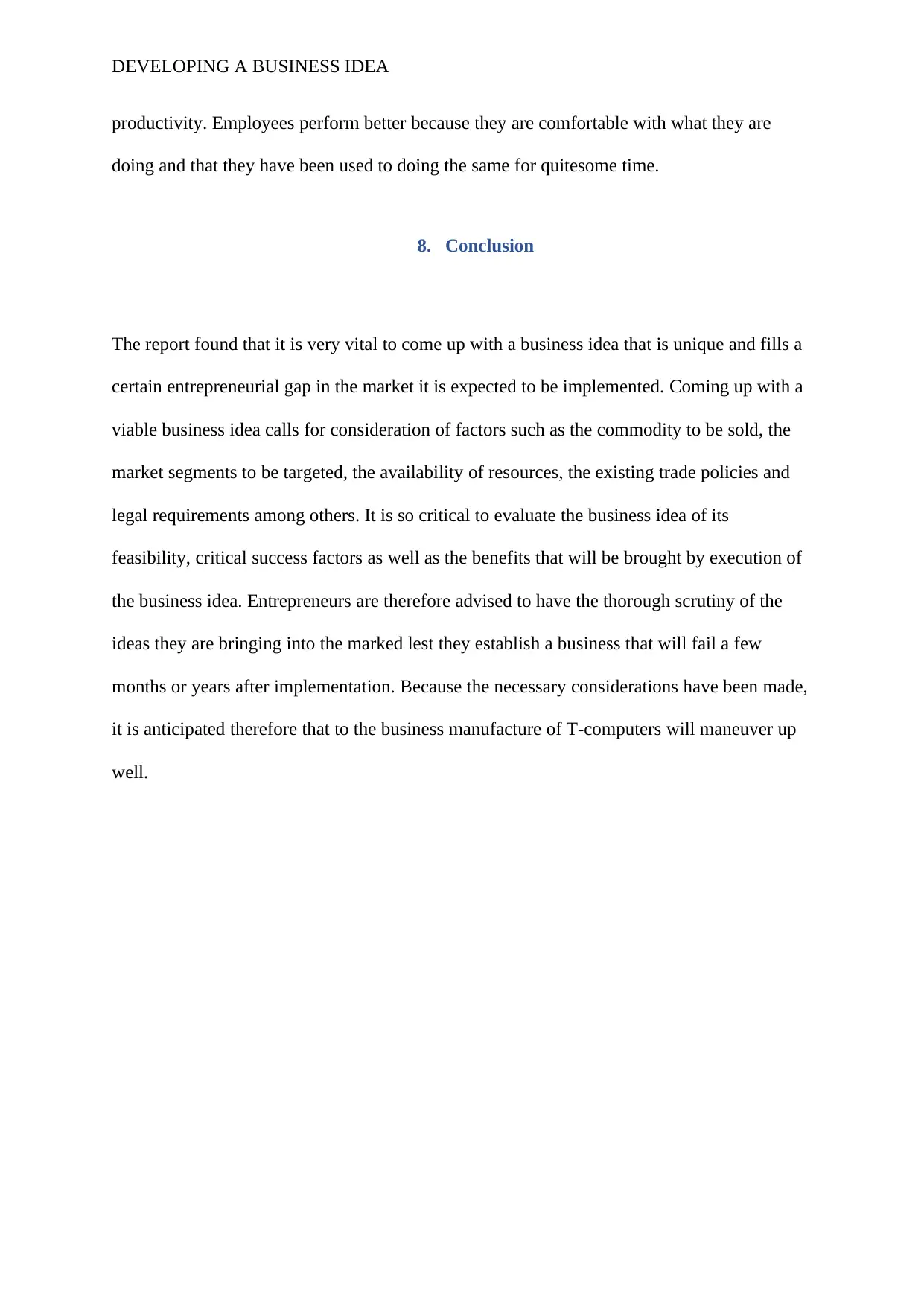
DEVELOPING A BUSINESS IDEA
productivity. Employees perform better because they are comfortable with what they are
doing and that they have been used to doing the same for quitesome time.
8. Conclusion
The report found that it is very vital to come up with a business idea that is unique and fills a
certain entrepreneurial gap in the market it is expected to be implemented. Coming up with a
viable business idea calls for consideration of factors such as the commodity to be sold, the
market segments to be targeted, the availability of resources, the existing trade policies and
legal requirements among others. It is so critical to evaluate the business idea of its
feasibility, critical success factors as well as the benefits that will be brought by execution of
the business idea. Entrepreneurs are therefore advised to have the thorough scrutiny of the
ideas they are bringing into the marked lest they establish a business that will fail a few
months or years after implementation. Because the necessary considerations have been made,
it is anticipated therefore that to the business manufacture of T-computers will maneuver up
well.
productivity. Employees perform better because they are comfortable with what they are
doing and that they have been used to doing the same for quitesome time.
8. Conclusion
The report found that it is very vital to come up with a business idea that is unique and fills a
certain entrepreneurial gap in the market it is expected to be implemented. Coming up with a
viable business idea calls for consideration of factors such as the commodity to be sold, the
market segments to be targeted, the availability of resources, the existing trade policies and
legal requirements among others. It is so critical to evaluate the business idea of its
feasibility, critical success factors as well as the benefits that will be brought by execution of
the business idea. Entrepreneurs are therefore advised to have the thorough scrutiny of the
ideas they are bringing into the marked lest they establish a business that will fail a few
months or years after implementation. Because the necessary considerations have been made,
it is anticipated therefore that to the business manufacture of T-computers will maneuver up
well.
⊘ This is a preview!⊘
Do you want full access?
Subscribe today to unlock all pages.

Trusted by 1+ million students worldwide
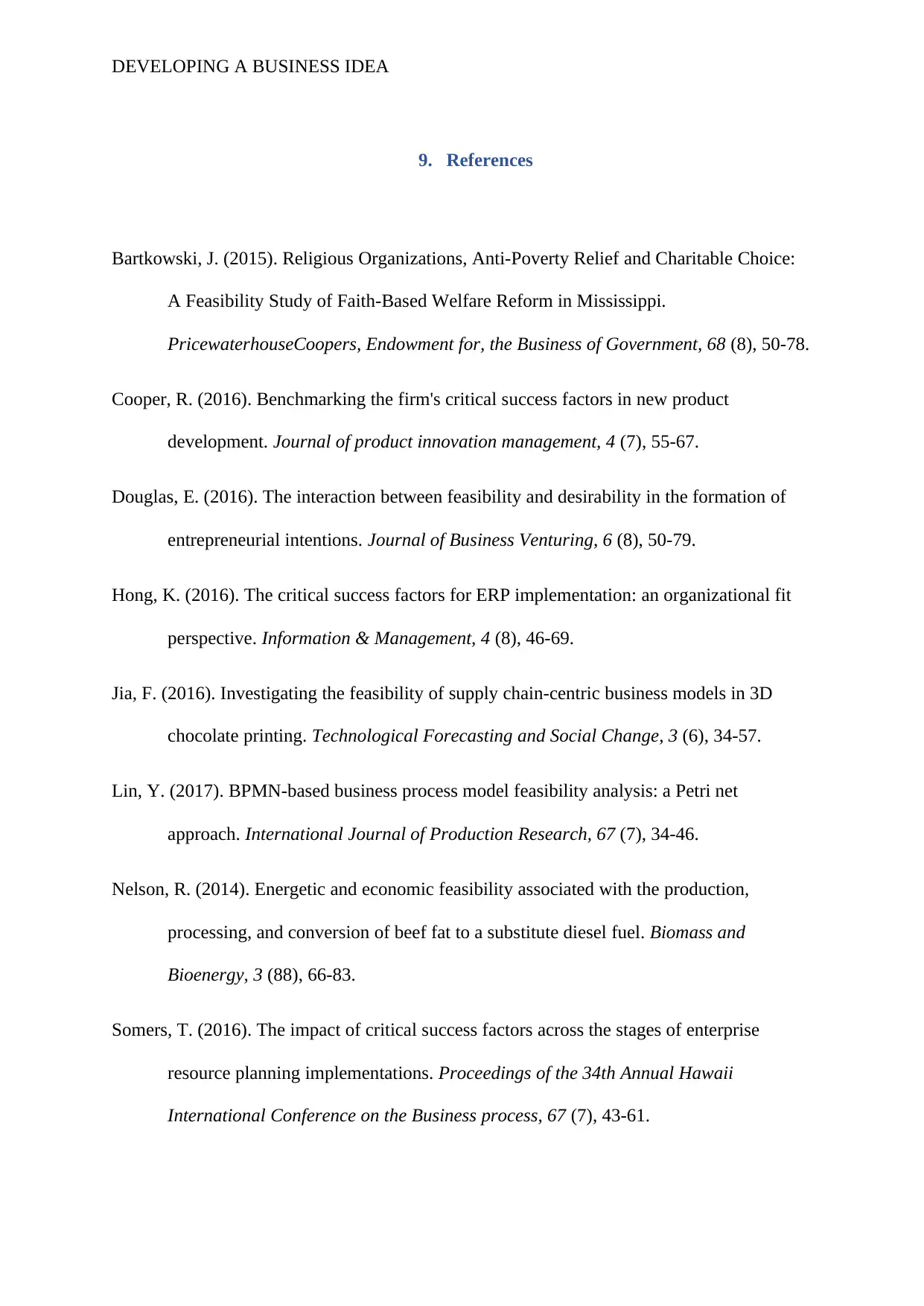
DEVELOPING A BUSINESS IDEA
9. References
Bartkowski, J. (2015). Religious Organizations, Anti-Poverty Relief and Charitable Choice:
A Feasibility Study of Faith-Based Welfare Reform in Mississippi.
PricewaterhouseCoopers, Endowment for, the Business of Government, 68 (8), 50-78.
Cooper, R. (2016). Benchmarking the firm's critical success factors in new product
development. Journal of product innovation management, 4 (7), 55-67.
Douglas, E. (2016). The interaction between feasibility and desirability in the formation of
entrepreneurial intentions. Journal of Business Venturing, 6 (8), 50-79.
Hong, K. (2016). The critical success factors for ERP implementation: an organizational fit
perspective. Information & Management, 4 (8), 46-69.
Jia, F. (2016). Investigating the feasibility of supply chain-centric business models in 3D
chocolate printing. Technological Forecasting and Social Change, 3 (6), 34-57.
Lin, Y. (2017). BPMN-based business process model feasibility analysis: a Petri net
approach. International Journal of Production Research, 67 (7), 34-46.
Nelson, R. (2014). Energetic and economic feasibility associated with the production,
processing, and conversion of beef fat to a substitute diesel fuel. Biomass and
Bioenergy, 3 (88), 66-83.
Somers, T. (2016). The impact of critical success factors across the stages of enterprise
resource planning implementations. Proceedings of the 34th Annual Hawaii
International Conference on the Business process, 67 (7), 43-61.
9. References
Bartkowski, J. (2015). Religious Organizations, Anti-Poverty Relief and Charitable Choice:
A Feasibility Study of Faith-Based Welfare Reform in Mississippi.
PricewaterhouseCoopers, Endowment for, the Business of Government, 68 (8), 50-78.
Cooper, R. (2016). Benchmarking the firm's critical success factors in new product
development. Journal of product innovation management, 4 (7), 55-67.
Douglas, E. (2016). The interaction between feasibility and desirability in the formation of
entrepreneurial intentions. Journal of Business Venturing, 6 (8), 50-79.
Hong, K. (2016). The critical success factors for ERP implementation: an organizational fit
perspective. Information & Management, 4 (8), 46-69.
Jia, F. (2016). Investigating the feasibility of supply chain-centric business models in 3D
chocolate printing. Technological Forecasting and Social Change, 3 (6), 34-57.
Lin, Y. (2017). BPMN-based business process model feasibility analysis: a Petri net
approach. International Journal of Production Research, 67 (7), 34-46.
Nelson, R. (2014). Energetic and economic feasibility associated with the production,
processing, and conversion of beef fat to a substitute diesel fuel. Biomass and
Bioenergy, 3 (88), 66-83.
Somers, T. (2016). The impact of critical success factors across the stages of enterprise
resource planning implementations. Proceedings of the 34th Annual Hawaii
International Conference on the Business process, 67 (7), 43-61.
Paraphrase This Document
Need a fresh take? Get an instant paraphrase of this document with our AI Paraphraser
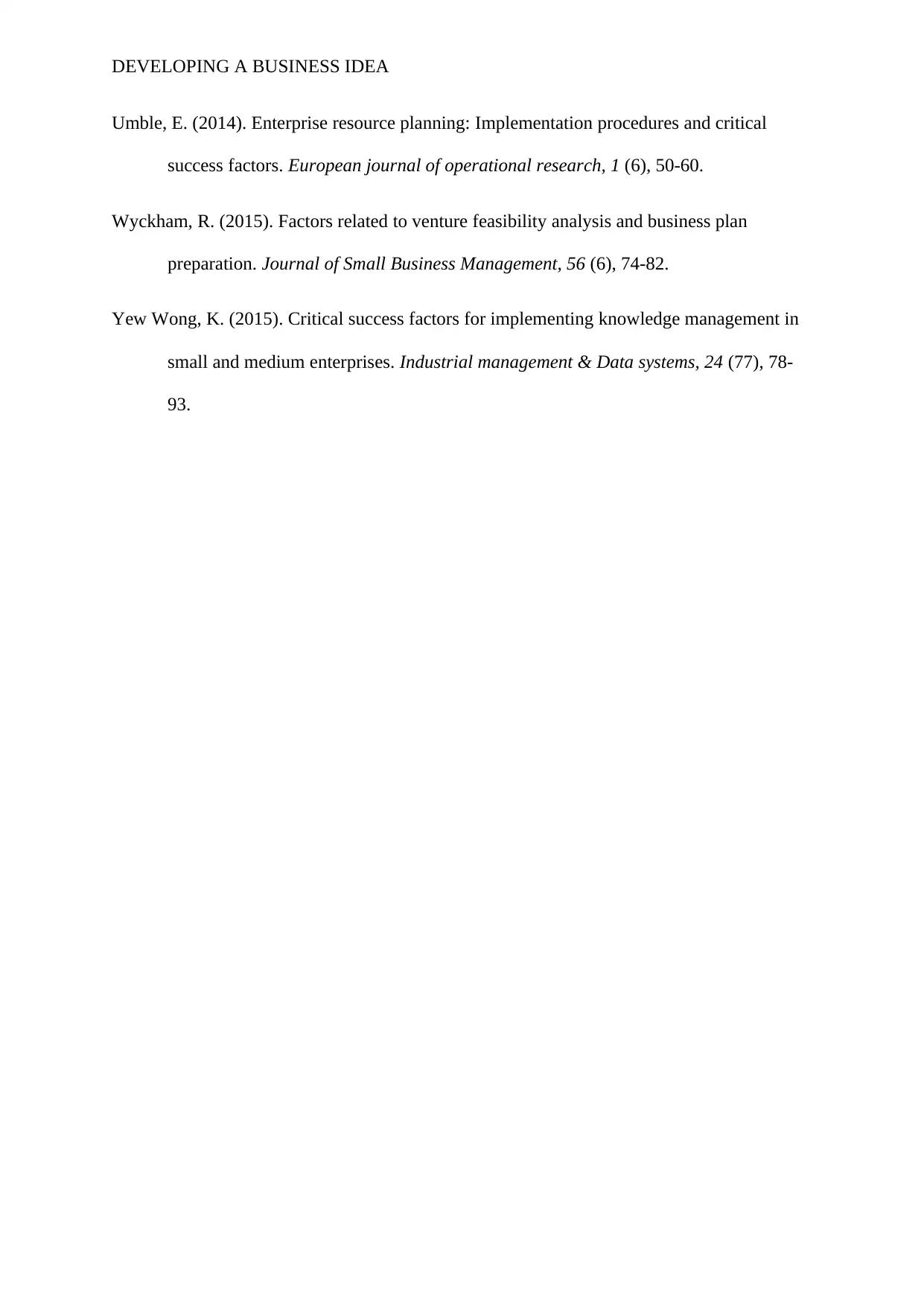
DEVELOPING A BUSINESS IDEA
Umble, E. (2014). Enterprise resource planning: Implementation procedures and critical
success factors. European journal of operational research, 1 (6), 50-60.
Wyckham, R. (2015). Factors related to venture feasibility analysis and business plan
preparation. Journal of Small Business Management, 56 (6), 74-82.
Yew Wong, K. (2015). Critical success factors for implementing knowledge management in
small and medium enterprises. Industrial management & Data systems, 24 (77), 78-
93.
Umble, E. (2014). Enterprise resource planning: Implementation procedures and critical
success factors. European journal of operational research, 1 (6), 50-60.
Wyckham, R. (2015). Factors related to venture feasibility analysis and business plan
preparation. Journal of Small Business Management, 56 (6), 74-82.
Yew Wong, K. (2015). Critical success factors for implementing knowledge management in
small and medium enterprises. Industrial management & Data systems, 24 (77), 78-
93.
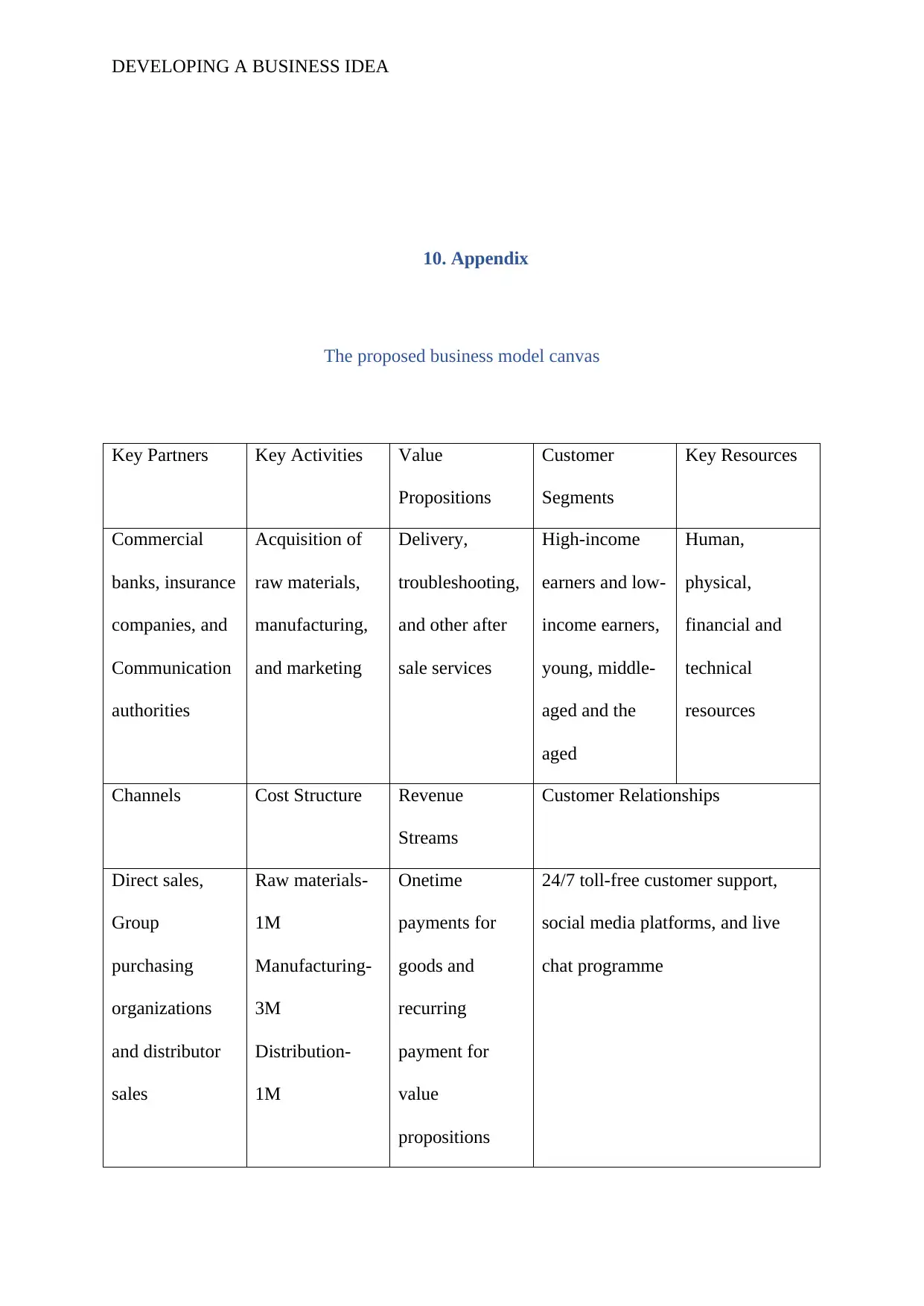
DEVELOPING A BUSINESS IDEA
10. Appendix
The proposed business model canvas
Key Partners Key Activities Value
Propositions
Customer
Segments
Key Resources
Commercial
banks, insurance
companies, and
Communication
authorities
Acquisition of
raw materials,
manufacturing,
and marketing
Delivery,
troubleshooting,
and other after
sale services
High-income
earners and low-
income earners,
young, middle-
aged and the
aged
Human,
physical,
financial and
technical
resources
Channels Cost Structure Revenue
Streams
Customer Relationships
Direct sales,
Group
purchasing
organizations
and distributor
sales
Raw materials-
1M
Manufacturing-
3M
Distribution-
1M
Onetime
payments for
goods and
recurring
payment for
value
propositions
24/7 toll-free customer support,
social media platforms, and live
chat programme
10. Appendix
The proposed business model canvas
Key Partners Key Activities Value
Propositions
Customer
Segments
Key Resources
Commercial
banks, insurance
companies, and
Communication
authorities
Acquisition of
raw materials,
manufacturing,
and marketing
Delivery,
troubleshooting,
and other after
sale services
High-income
earners and low-
income earners,
young, middle-
aged and the
aged
Human,
physical,
financial and
technical
resources
Channels Cost Structure Revenue
Streams
Customer Relationships
Direct sales,
Group
purchasing
organizations
and distributor
sales
Raw materials-
1M
Manufacturing-
3M
Distribution-
1M
Onetime
payments for
goods and
recurring
payment for
value
propositions
24/7 toll-free customer support,
social media platforms, and live
chat programme
⊘ This is a preview!⊘
Do you want full access?
Subscribe today to unlock all pages.

Trusted by 1+ million students worldwide
1 out of 12
Related Documents
Your All-in-One AI-Powered Toolkit for Academic Success.
+13062052269
info@desklib.com
Available 24*7 on WhatsApp / Email
![[object Object]](/_next/static/media/star-bottom.7253800d.svg)
Unlock your academic potential
Copyright © 2020–2025 A2Z Services. All Rights Reserved. Developed and managed by ZUCOL.





